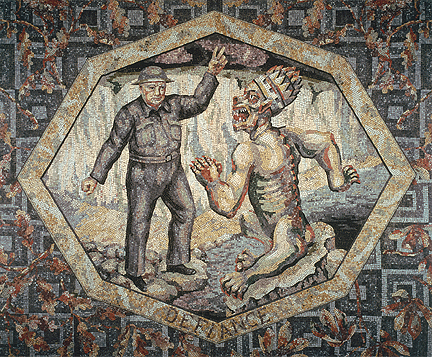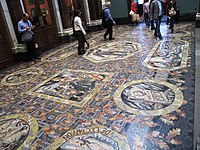
The first picture that often greets our visitors is not an Old Master, nor an Impressionist. Nor does it even hang on a wall. In the Gallery's Portico entrance is 'The Awakening of the Muses', a marble mosaic laid in 1933: http://bit.ly/1HpHN3O
Mosaics in the Portico
The first picture that greets visitors to the National Gallery is not an Old Master, nor an Impressionist. Nor does it even hang on a wall. Set into the floor of the first landing in the Gallery's Portico entrance is 'The Awakening of the Muses', a marble mosaic laid in 1933 by the Russian-born artist Boris Anrep (1885-1969).
Between 1928 and 1933, the National Gallery commissioned Anrep to lay two mosaic pavements in the vestibule of the Main Hall to illustrate 'The Labours of Life' and 'The Pleasures of Life'. In 1952, Anrep laid a third pavement, 'The Modern Virtues'. The resulting mosaics are a celebration of everyday life, which lies underfoot in a busy public place.
Anrep was an associate of the Bloomsbury Group of artists and writers, who notoriously championed modern art and modern attitudes. His Muses are not heavenly immortals, but portraits of people from his own world. Many of the characters are played by Anrep's Bloomsbury friends.
Famous faces
Celebrated people of the day shown in the mosaics include:
- The film star Greta Garbo as Melpomene, Muse of Tragedy
- Bloomsbury writer Virginia Woolf wielding an elegant pen as Clio, Muse of History
- Sir Winston Churchill as Defiance
- The ballerina Dame Margot Fonteyn as Delectation
- The philosopher Bertrand Russell as Lucidity

Prime Minister Winston Churchill depicted as Defiance
There are many more, including art critic Clive Bell as a rather sober Bacchus. Anrep and Bell had first worked together in 1912, selecting works for the art critic Roger Fry's second controversial Post-Impressionism exhibition.
Anrep was one of the foremost mosaicists in Britain. His work can also be seen at Tate Britain and in Westminster Cathedral.
*****Wikipedia
Boris Vasilyevich Anrep (Russian: Борис Васильевич Анреп) (27 September 1883 – 7 June 1969) was a Russian artist, active in Britain, who devoted himself to the art of mosaic.
In Britain, he is known for his monumental mosaics at the National Gallery, London, Westminster Cathedral and the Bank of England. Being close to the Bloomsbury Group, he was a noticeable figure in London social and intellectual life from 1912 up to the mid-1960s.
In Ireland, he is known for his mosaics at Christ the King Cathedral, Mullingar.
In Russia, he is associated with the Silver Age of Russian Poetry as the addressee of many beautiful poems by Anna Akhmatova, including her Tale of the Black Ring. Anrep was also friendly with Nikolay Gumilyov, an outstanding poet and Akhmatova's husband, and Nikolay Nedobrovo, a talented critic, two prominent figures of the 1910s in Saint Petersburg.
Contents [hide]
1 Life and works
1.1 Early years
1.2 Anna Akhmatova and Boris Anrep
1.3 Early commissions in England
1.4 Saint Sophia Cathedral
1.5 Commissions in Mullingar, Ireland
1.6 National Gallery mosaics (1928–52)
2 References
3 External links
National Gallery mosaics (1928–52)[edit]
Anrep created four colourful mosaics, which decorate the imposing staircase built by Sir John Taylor in 1887 for the entrance hall of the National Gallery. The mosaics were paid for by private patrons, mainly the industrialist Samuel Courtauld and Anrep's friend Maud Russell, wife of the banker Gilbert Russell. Anrep described the subject as a philosophical cycle.
The Labours of Life in the west vestibule (1928) illustrates Man's constructive and creative nature. It includes working with electric drill (Engineering), filming a zebra (Exploring), washing a pig (Farming) and studying the diplodocus in the Natural History Museum (Science). Other pictures are Sacred Love (a family), Art, Astronomy, Letters, Mining, Commerce (a Covent Garden porter), Music (a shell and a flute), and Theatre (a contorsionist).
The Pleasures of Life in the east vestibule (1929) shows Man's recreations. The subjects areContemplation, Conversation, Football, Hunting, Cricket. Girls are depicted riding a motorcycle (Speed), wiggling in a hammock (Rest), jiving charleston (Dance), swimming (Sea-Horse).Christmas pudding and Mud Pie are childish, while Profane Love shows a man with two girls.
The Awakening of the Muses on the half-way landing (1933) links the themes of the first two mosaics. At the crowing of the cock, Bacchus, patron of pleasures, and Apollo, who inspires the labours, awaken the muses. Here the figures are portraits of the artist's contemporaries. Apollo is Sir Osbert Sitwell, Bacchus is Clive Bell. Polyhymnia is represented as Diana Mitford, Clio as Virginia Woolf. Melpomene is Greta Garbo, and Terpsichore is prima ballerina Lydia Lopokova, Lady Keynes. Euterpe as Lady Christabel Aberconway. Urania as Maria Volkova. Calliope as Anna Akhmatova. Erato as Mary Hutchinson. Thalia as Lady Lesley Jowitt.
Modern Virtues in the north vestibule (1952) is a record of the intellectual life of the 1930s and 1940s. Compromise is presented by the American actress Loretta Young, wearing a Phrygian cap as well as a crown; Curiosity is Lord Rutherford with a splitting atom; SirWinston Churchill defies a beast in a shape of swastika (Defiance). The ballerina Margot Fonteyn listens to the writer and musician Hon. Edward Sackville-West playing the harpsichord (Delectation); Lady Diana Cooper as Britannia crowns Punch (Humour); the poetT. S. Eliot features in Leisure, Bertrand Russell illustrates Lucidity. The astronomer Fred Hoyle, Augustus John and the poet Edith Sitwell and are portrayed respectively in Pursuit, Wonder and Sixth Sense (named after the poem by Gumilyov). Compassion is a portrait of Akhmatova surrounded by the horrors of war.[2] She is looking towards another panel which depicts Anrep's gravestone, linking together his art and her poetry.



沒有留言:
張貼留言